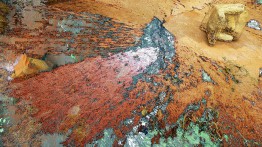The Turned Room
Wed, Sep 6, 12pm - Wed, Sep 27, 2023 5pm

As a recipient of the Arnold W. Brunner/Katherine Edwards Gordon Rome Prize, Associate Professor Michael Young occupied the Philip Guston Studio at the American Academy in Rome from May 13th to June 16th, 2023. Over the course of four weeks, he undertook an experiment in representation specifically constrained by this time and place. Everything that he worked on was already in the room; nothing could be brought in or removed. Working in the studio every afternoon from 2:00 until 8:00, he created three-dimensional photogrammetry models from data points gathered through digital images captured with an iPhone. The captures were a sequence of 15–40 images taken as a series of still frames moving around an object. Each week, he took a different object—a chair, a phone, a desk, a series of drawers—and positioned it on the floor in the space as an object of focus. These objects allowed him to capture the background of the room with relative gradations, from highly detailed to loosely defined, shifting in resolution from realism to abstraction. The weeklong setup also allowed him to capture the room at different times of day, with different qualities of light from different directions, and with different spectrums of color hue. The models consisted of points and only points, averaging around 25 million per model. Selected views of the point-cloud models were extracted at three different resolutions and overlayed as color field studies to develop a specific mood and palate. The proportions of the prints resulting from this process are the proportions of the room. Each object was also turned in relation to gravity, creating—when modeled three dimensionally and viewed from multiple angles—an ambiguity around what was turned: the object, the model, or the room.
Photogrammetry models approximate the location and color of a point in space from multiple images of the point. No hierarchical difference between an object and its context is predetermined; everything in the environment becomes evenly captured energetic data, a homogeneous field of colored marks in a matrix, sometimes appearing abstract, at other times, realistic. These patterns of hue values appear at different densities depending on the resolution of the initial images and the confidence the software has in triangulating spatial location. Another way to say this is that there are no figures determined by a contoured edge, only grounds of variable hue, saturation, and brightness. Spatial depth is a computational displacement created by approximation from local regions of color pattern difference.
Questions of variable resolution of mark making, color patterns, figure/ground, and realism/abstraction, seem to be old aesthetic issues typically related to “formalism” within late 19th and early 20th century art theory. But with the current use of these scanning technologies and photogrammetry models, these exact same issues have mutated into a different set of valuations for a multitude of disciplines and interested agencies, including, to list a few: petroleum extraction, climate change studies, underwater exploration, military targeting operations, weather simulations, forensic reconstructions, police surveillance, fauna-migration tracking, autonomous vehicle navigation, agricultural management, and advertising campaigns. What remains is for architects to articulate a working space within an imaging technology that hovers between observation and speculation, with representations that are rendered as realism from the drop, and with space conditioned by the fluctuation of background energy. These experiments from The Turned Room offer no conclusions, they only posit starting points, and more questions.
On Tuesday, September 19 at 6:30 pm Young will hold gallery remarks for the exhibition in the Third Floor Hallway.
Open to Cooper Union students, faculty, and staff. 
Exhibitions and events presented by The Irwin S. Chanin School of Architecture Archive are made possible by the New York State Council on the Arts with the support of the Office of the Governor and the New York State Legislature.
Located at 7 East 7th Street, between Third and Fourth Avenues




